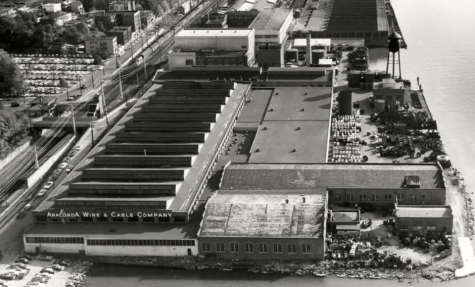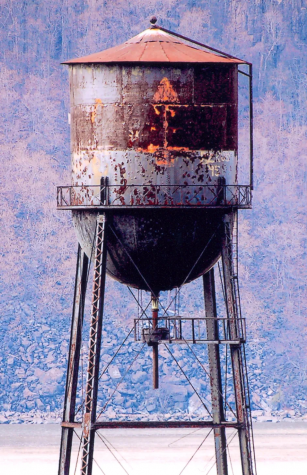A Change of Scenery: Worrisome Water Tower Woes

An as-built drawing of the water tower from the 1920s-1930s
March 22, 2021
A cherished edifice rooted in the town’s heritage, the Hastings water tower is more than a structure to the many residents who catch a glimpse of it each day. It’s an iconic anomaly, an exception to the town’s basic fixtures along the waterfront, and its presence has left an indelible impression on the vista of the Hastings Skyline. With a complex history, the water tower’s past is now the cause for a plan that will alter one of the few century-old constants in Hastings’ panoramic views of the Hudson River.

From Fires to Wires
The water tower’s past and future are understood by no one better than Morgen Fleisig, Hastings Trustee and foremost expert on the subject. As he explained, the water tower’s current site once belonged to the Hudson River Steam Sugar Refinery, which operated for three decades before burning down in 1875. It was soon followed by the Hastings Pavement Company, whose hexagonal pave stones—which can still be found in Central Park and Prospect Park—are walked on by millions each year. In 1922, the Anaconda Wire & Cable Company erected a facility that included the water tower and was later granted a contract by the U.S. Navy during WWII to create PCBs, or polychlorinated biphenyl, in order to fireproof electrical cables. The PCBs that leaked from this industrial plant were absorbed by the surrounding environments, contaminating the land, river water, and river sediment. A virulent toxin, PCBs have adverse effects on the immune, reproductive, endocrine, and neurological systems of both humans and animals, and cause a variety of life-threatening cancers, according to the U.S. Environmental Protections Agency. Today, the danger posed by these chemicals has not lessened, a constant reminder why the current remediation plans for the waterfront, and its iconic water tower, are pivotal to ensure a cleaner, safer Hastings.

Baseline Logistics
The remnants of this production site have proven to be an onerous challenge for Hastings over the past 20 years. Recently, however, substantial advances have been made thanks to dedication from people like Trustee Fleisig.
The water tower sits on 28 acres of land that must be remediated, a lengthy process which includes stabilizing the area and ridding it of PCBs. The process for doing this work, along with any prospects for the water tower, was outlined in a document known as the Consent Decree, an agreement between the town and BP ARCO, the oil-and-gas giant who currently owns the property.
The town’s desire to keep the water tower, which was bolstered by a community poll from a few years back, has opened two funding sources for the much needed work along the waterfront. BP ARCO is willing to match any money the town raises for this cause, up to $1.53 million, as well as to divert the funds that would be needed to destroy the water tower. As a result, this would provide an economic backing for the proposed project.

Salvaging the Surrounds
The first remediation procedure, known as OU-1 or Operable Unit 1, would involve rebuilding the concrete docks that currently support the water tower after determining toxic and structurally unstable areas. Trustee Fleisig described the new foundation to replace the decrepit docks as a “geotechnical sandwich,” a layered rock-bed starting with large boulders, then covered with small gravel, and finally topped with fine earth.
The second remediation procedure, known as OU-2 or Operable Unit 2, would require removing the layers of PCB accumulations in the river bed that accrued over the factory’s lifespan, a process known as dredging. Requiring the utmost precision, this part of the remediation involves the usage of turbidity curtains, which help avert ecological catastrophe by preventing the fine layers of PCB-ridden silt from escaping to the rest of the river. OU2 is a time-restricted project as it cannot coincide with the Atlantic Sturgeon “runs,” periods of the year when large quantities of these endangered, prehistoric fish swim up-river to their spawning grounds. Work between the NYS Department of Environmental Conservation and BP ARCO, however, has been able to safely shorten the fish run period when work must be ceased, thus truncating the 5-7 year restoration by at least a year. Finally, the water tower’s lead paint covering, toxic to the human body, must be removed or encapsulated by another layer of paint. If dust from this paint were to get in the air during the water tower’s removal, ingestion could cause damage to vital organs. Although in-depth and extremely technical, these plans are only one step in this complex process.

Proposals, Punctuality, Perfection
Before extensive remediation can occur, though, the water tower must be moved from the location etched in the minds of most Hastings’ residents. While no conclusion has been made to officialize a plan, Trustee Fleisig described the two proposals being considered.
Originally, the idea for the water tower was to dismantle it by unbolting the individual parts. Once separated and reduced to a fraction of the size, it would be stored at the marina to the immediate north of Harvest-on-Hudson. Yet the pieces of the water tower are riveted rather than bolted, meaning that it would have to be cut instead of taken apart. Having considerable experience moving and disassembling large sculptures, however, Trustee Fleisig stated that the water tower would never look the same after reconstruction, and offered a better solution to guaranteeing the structure’s preservation.
Unlike the first proposal, which was created through collaboration, Trustee Fleisig’s idea was self-generated and is now a major contender for the town’s final plan. Diminishing the chance of irreparable damage, it entails hoisting the water tower with a crane and transporting it to a suitable town-owned location along the river. Discussions between Trustee Fleisig and the famed rigging company Weeks Marine – who was responsible for moving the space shuttle onto the Intrepid – yielded auspicious results. By welding four eye-hooks near its top, unbolting its legs from the ground, and then tying them together for stabilization, Weeks Marine said that the process of lifting and relocating the water tower would take a day, with the only determinant being weather. The last stage of Trustee Fleisig’s proposal would be coming to consensus on the interim-location for the water tower. The “temporary residence” could be inhabited for up to 10 years in its entirety due to factors like site mobilization prolonging the remediation procedure. Despite its immense appearance, the tower’s base is a square, roughly 35 ft in length, allowing for a few possible interim locations. The town has been examining the aforementioned marina as well as different places within MacEachron Waterfront Park, but still has to garner approval from town residents. Since a foundation will need to be constructed, residents must acknowledge that the water tower will rest in this location for the better part of a decade, and possibly indefinitely.

Potential Permanence
While BP ARCO owns the site, a company called National Resources – who developed residential units in Tarrytown – has a contract with BP ARCO to redevelop the land along the waterfront. Although they haven’t released any plans, National Resources may refuse the water tower returning to its original location, though this is unlikely. Among other things, this is due to the fact that the town and BP ARCO have devised an agreement where both parties will have finalized their proposals for the waterfront – which also include future site designs – by years end or early 2022. The moving of the water tower would then begin by 2023. If the town’s proposal is not prepared by this date, BP ARCO has given fair warning that they intend to tear down the water tower, as it’s just a hindrance to them. These proposals’ new site designs for the post-remediation waterfront will be comprehensive, and though the water tower may be conserved, that won’t warrant it being included in the reimagined shoreline infrastructure.
As noted by Trustee Fleisig, no other issue in Hastings’ has invoked such fervor from its residents as the water tower, a testament to the incredible historical and cultural importance that the town associates with it. The enactment of a plan is definite, but whether it may redefine the riverscape of Hastings is entirely in question, enshrouded by a similar mystery to the one that engrosses those who catch their first glance of the incongruous, weathered structure.

















